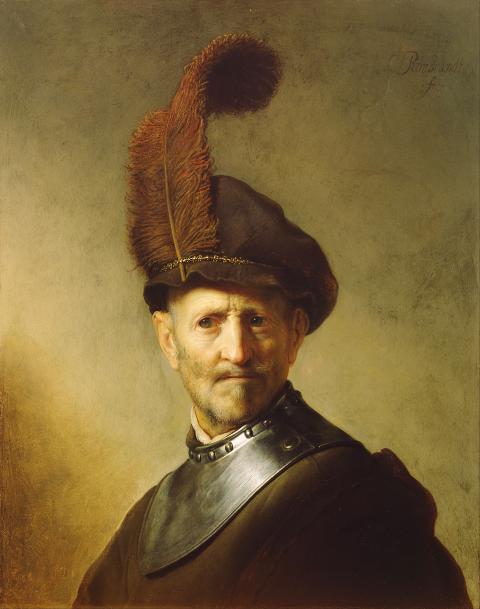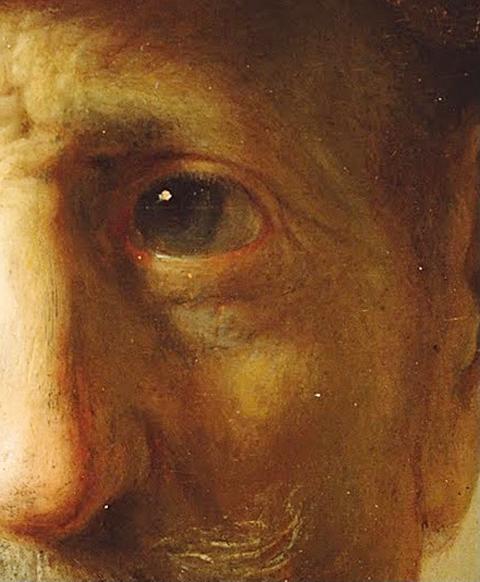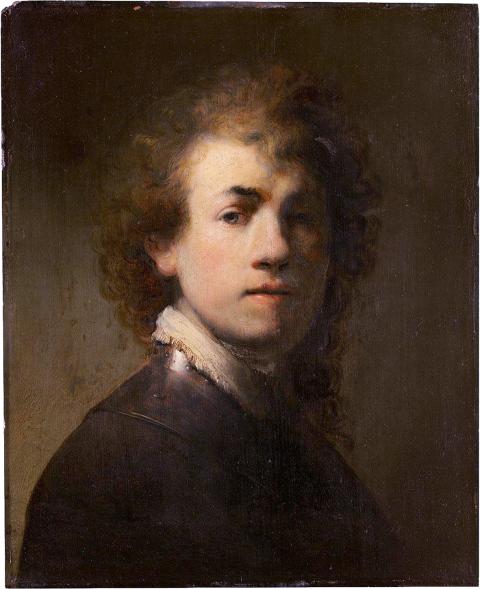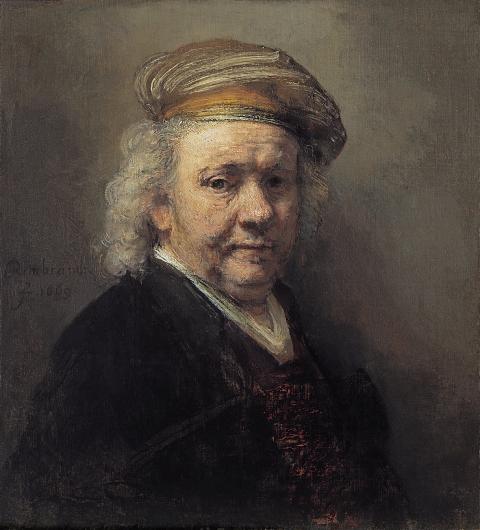The 17th century has been called the Dutch Century. In this “Dutch Golden Age,” the Netherlands achieved global success in trade, science and technology, warfare and art, and it became a colonial power with a reach that even extended as far as Taiwan.
The Netherlands at the time was a commercially prosperous country, and paintings depicting scenes of city life, or still life paintings to adorn people’s walls, were very much in demand. Although stylistically influenced by the Protestantism that emerged after the Reformation, Dutch art was far less ostentatious and far simpler than the Baroque style found elsewhere in Europe.
Rembrandt Van Rijn (1606-1669) obtained the majority of his income, and much of his renown, from his depictions of Biblical stories and his portraiture.

Photo: Wikimedia commons
圖片:維基共享資源
His technique was very much influenced by Italian Baroque art, particularly Caravaggio’s chiaroscuro technique, but he was far less preoccupied with the beauty of Italian art, and in fact did little to conceal flaws.
Around one-tenth of Rembrandt’s extant works are self portraits. These include oil paintings, etchings and sketches. The painter scrutinized his own visage from when he was a young man in his twenties to the final year of his life. The young Rembrandt shows a man in his prime; the older Rembrandt was painted at a time when he was bankrupt and his loved ones had passed away. The self-portraits, spanning over 40 years of his painting career, show us how he accumulated his own visual diary, depicting himself with utmost candor and profundity.
He would often apply deep shadow tones to the canvas, and then complement them with similarly dramatic highlights to small areas of detail, such as on the face, to create a strong contrast between light and shadow reminiscent of dramatic stage lighting. The extreme shadows made the areas of light shimmer, to great theatrical effect.

Photo: Wikimedia commons
圖片:維基共享資源
Modern photography and movie making techniques have also been influenced by the artist: “Rembrandt lighting,” for example, is named after him. This refers to a lighting technique Rembrandt himself made liberal use of, and which would typically create a triangle of light on the face (see picture 2). With this lighting arrangement, the shadows of the nose and the cheeks would merge and, more importantly, the eye on the shaded side of the face would retain its specular highlight. This would mean that the eye would still appear bright and expressive, enhancing the dramatic effect of the picture.
(Translated by Paul Cooper)
史上常言十七世紀是荷蘭的世紀,在這「荷蘭的黃金時代」,荷蘭的貿易、科技、軍事、藝術都有引領世界的成就,其海外拓殖勢力也遠及台灣。

Photo: Wikimedia commons
圖片:維基共享資源
當時,荷蘭由於商業發達,描繪市民生活與作為裝飾用的靜物畫因市場需求而成為主流;另外,因宗教改革後新教的影響,即便是描繪宗教主題,荷蘭藝術相較於巴洛克的華麗也較為樸實。
林布蘭(一六○六-一六六九年)當時便以宗教故事畫及肖像畫為主要收入來源,並享有盛名。
林布蘭的技法受前代義大利巴洛克藝術影響,尤其是卡瓦拉喬的明暗對照法,但不同於義大利藝術的美麗形象,他似乎毫不關心美,甚至對醜陋毫不掩飾。

Photo: Wikimedia commons
圖片:維基共享資源
林布蘭傳世的作品中,約有十分之一為其自畫像,包括油畫、蝕刻版畫與素描。由二十出頭的青年到生命最後的一年,畫家凝視著自己。儘管少年得志,但他晚年破產、親人離世,由他橫貫四十多年的自畫像中,我們彷彿可以閱讀他誠實、深邃地面對和挖掘自己的生命日記。
林布蘭的畫面處理常以灰暗為基調,而在臉部等小部分特寫處以相對極明亮的光線處理,這種明暗對比手法像是舞台打光;極度的暗,讓小區域的光變得炫目,營造了場面的戲劇張力。
現代攝影與電影技巧也受到林布蘭影響,「林布蘭光」即以他為名。這是他常用的佈光手法,臉上的三角形光即為典型(如圖二)。在這樣的佈光中,鼻子與臉頰的影子相連,更重要的是,陰影中的眼睛依然有眼神光,以保持炯炯有神的面貌,使照片有戲劇感。
(台北時報林俐凱)

Have you ever dreamed of using an entire city as your training ground, effortlessly moving across walls, buildings, stairs, and obstacles? This is not just a fantasy from the movies. In cities around the world, a group of enthusiasts practice this seemingly impossible sport — “parkour.” The origins of parkour can be traced back to 20th-century France. A military officer named Georges-Hebert witnessed the incredible physical abilities of local residents in Africa, which inspired him to create the Methode Naturelle, or natural method. This training method cleverly combined climbing, running, and swimming with artificial barriers to mimic nature. Later, David Belle

Street lights are often taken for granted until a power outage plunges the world into darkness. When that happens, the value of these lighting installations becomes evident as the world turns into a more dangerous place for pedestrians and motorists alike. The Chinese could claim to be the first to have constructed a crude type of street light. Around 500 BC, residents of Beijing employed a type of street lamp that used hollow bamboo pipes and natural gas vents to create burning torches. Later, ancient Romans adopted lamps fueled by vegetable oil, which relied on slaves to light and

A: Who else is on Billboard’s list: “The 25 greatest pop stars of the 21st Century?” B: No. 15 to 6 are: Miley Cyrus, Justin Timberlake, Nicki Minaj, Eminem, Usher, Adele, Ariana Grande, Justin Bieber, Kanye West and Britney Spears. A: I can’t believe that Adele’s only at No. 10. B: No. 5 to 1 are: Lady Gaga, Drake, Rihanna, Taylor Swift and Beyonce. A: Well, they surely deserve the honor. A: 《告示牌》雜誌的「21世紀最偉大的25位流行歌手」,還有誰上榜啊? B: 第15至6名是:麥莉希拉、大賈斯汀、妮姬米娜、阿姆、亞瑟小子、愛黛兒、亞莉安娜、小賈斯汀、肯伊威斯特、小甜甜布蘭妮。 A: 真不敢相信愛黛兒只排第10名。 B: 第5至1名是:女神卡卡、德瑞克、蕾哈娜、泰勒絲、碧昂絲。 A: 這幾位真是實至名歸! (By Eddy Chang, Taipei Times/台北時報張聖恩)

A: The 21st Century is now entering its 25th year. B: So Billboard has released a list: “The 25 greatest pop stars of the 21st Century.” A: Who are the greatest pop singers? B: No. 25 to 16 are: Katy Perry, Ed Sheeran, Bad Bunny, One Direction, Lil Wayne, Bruno Mars, BTS, The Weeknd, Shakira and Jay-Z. A: Wow, my favorite K-pop supergroup BTS has made it to the list. A: 21世紀正在邁入第25個年頭了。 B: 《告示牌》雜誌特別公布:「21世紀最偉大的25位流行歌手」。 A: 最偉大的歌手有哪些? B: 第25至16名是:凱蒂佩芮、紅髮艾德、壞痞兔、1世代、小韋恩、火星人布魯諾、防彈少年團(BTS)、威肯、夏奇拉、Jay-Z。 A: 哇,我最愛的韓流天團BTS也上榜了! (By Eddy Chang, Taipei Times/台北時報張聖恩)